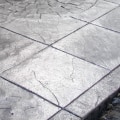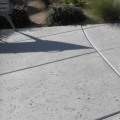The concept of staining concrete is similar to altering the color of materials such as wood. Instead of creating an opaque surface through paint, staining provides various shades and shades for concrete through different solutions and techniques. Practice makes perfect when staining concrete, and home and business owners can master the art of creating concrete textures that resemble the tones of natural stone, leather, marble, and wood. Stained concrete floors are beautiful additions to home and business interiors alike.
When selecting a dye for interior concrete, keep in mind that acid-based dyes are good for high-traffic floors due to their longevity, while water-based dyes are easier to apply, require less cleaning, and are not as toxic. Acid-stained concrete floors have an old-world marbled look that blends well with stone and wood and helps bring timeless appeal to your interior spaces. Water-based stain colored concrete floors will have a more vivid and consistent coloration suitable for more modern interior designs. Staining and polishing are two methods of treating the surface of a concrete floor slab.
Tinted concrete specifically refers to the process of applying an acid- or water-based colored dye to alter the appearance of the floor. Stains may vary in appearance and durability, but the resulting floor must be treated regularly with waxes or other sealants to maintain the aesthetic appearance. Failure to regularly care for stained concrete can quickly cause colored surface wear in high-traffic areas, leaving bare concrete patches that begin to “dust off” and absorb contaminants. Repairing these areas can be difficult.
Acid-stained concrete floors are a low-cost floor option. Coupled with customizable color, acid staining and sealing ensure additional durability and lifespan to any indoor or outdoor concrete floor. Templates made for use in concrete can also be used to create stunning designs with concrete stains. In addition, acid stains can take up to 24 hours to fully react with the concrete surface, which can be prohibitive for some projects.
A concrete stain can often be installed quickly and at a similar or lower cost than most other flooring options. Notice how all the natural variety on the concrete surface is still visible after polishing the floor to a high gloss. If you're not satisfied with the color of your stained concrete or want to freshen up concrete that has been stained a long time ago, there are a few options. The color of the patio is uniform overall, while the entrance has a mottled appearance due to the chemical reaction of stains and concrete.
Like tile, slab and natural stone, a concrete and grout base is generally required for a semi-permanent slab, which means that it has the same disadvantages as tiles. While both film-forming and penetrating stains rely on color pigments to alter the decorative appearance of concrete, acid stains chemically react with minerals in the concrete to generate a natural-looking marble appearance by physically etching the surface. Although not technically a concrete stain, integral color is a pigment that is added directly to a concrete mix before pouring. Because of this, they can be used to create intricate designs or even add a corporate logo to a concrete floor.
Like paint, film-forming spots simply coat or place on a concrete surface to add color to the concrete surface. In short, staining is usually a good option if you currently have a concrete slab that you would like to add color to. A more permanent alternative to film-forming stains are penetrating stains, which are designed to literally penetrate deeper into concrete pores and bond to concrete. It's best to contact the person who sealed your patio the first time to find out what type of sealant you should use to coat your decorative concrete.
While tinted and polished concrete can be a useful option for specific applications, the use of epoxy polymers in floors continues to grow significantly, and with good reason. . .



Leave Reply